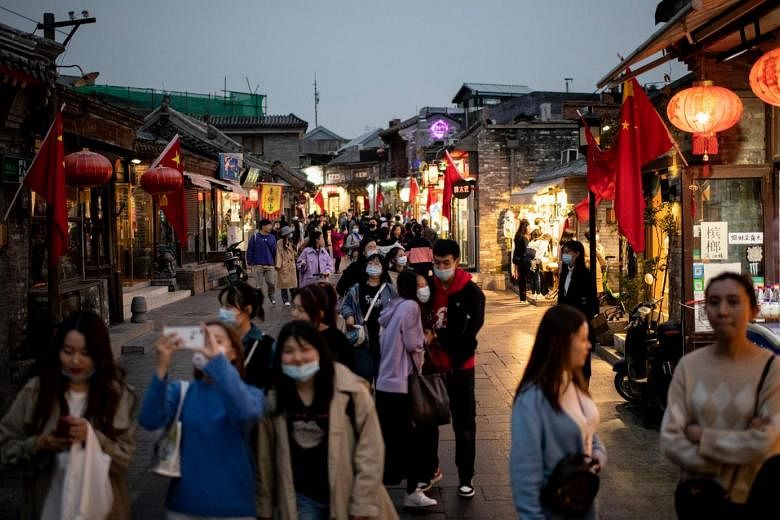BEIJING - Trains were packed, tourist attractions crowded and airports crammed - these were the scenes across China during its just ended eight-day National Day holiday.
They were an unusual sight in a world gripped by the Covid-19 pandemic where many countries are still recording mounting infections and contemplating renewed lockdowns.
But not so for China which reported the first case in the world late last year.
The national "Golden Week" holiday - which was extended by a day this year because of the Mid-Autumn Festival - saw 637 million domestic trips being made, about 79 per cent of the 782 million trips in 2019, just released figures from the Ministry of Culture and Tourism showed.
The travel rush generated 466.56 billion yuan (S$94.3 billion) in tourism revenue, about 70 per cent of that generated during last year's holiday stretch.
This year's Golden Week travel rush has been closely watched as a barometer of China's economic recovery.
While Chinese state media extolled the initial figures as evidence of the country's robust recovery, some economists had expected the numbers to be higher which suggested the pandemic and the economic slowdown were still weighing on Chinese consumers.
The official China Daily said in an editorial on Thursday (Oct 9) that while the figure did not match last year's, it still reflected a "strong recovery in consumer confidence" and a "palpable widespread post-epidemic feel-good mood".
"If this momentum can be maintained, the Chinese economy - which surged 3.2 percent in the second quarter from the 6.8 percent fall in the first quarter - might realise substantial positive growth this year, despite the combined blows it has taken from the pandemic and the US administration's containment and protectionist policies," said the newspaper.
China's economy is projected to grow 2 per cent this year, the World Bank has estimated, and is widely expected to be the only major economy to register positive growth.
In Hubei province, where the virus was first discovered in December last year, tourists were back out in force, said tour guide Guo Qiang, who told The Straits Times that some popular tourist sites appeared to have more visitors after entry fees were abolished to draw in crowds.
"I am quite optimistic about the tourism industry in Hubei. Tourists now are not worried about the pandemic anymore because they know it's very safe in China," said the 31-year-old, adding that he has a packed month of bookings.
In a report released on Friday (Oct 9), the Chinese travel services provider, Trip.com Group, called tourism a "bright spot" in the country's economy and said the holiday period had seen a strengthening of consumer confidence.
"We remain optimistic about travel and are encouraged by the pace of recovery in China," said the group's chief executive Jane Sun.
Shanghai-based independent economist Ye Tan said that many Chinese used to travel overseas during the Golden Week period, but with international travel not possible now, that demand has shifted to the domestic market.
"The outlook from tourism seems positive and I think it's a good sign for consumption in other areas as we move forward," she said.
But others remained less sanguine about prospects.
Political economist Hu Xingdou said the fact that tourism spending did not recover to last year's levels showed that Chinese consumers were still cautious about the economic impact of the pandemic.
He pointed out that many people had lost their jobs and fewer consumers had enough spending power to travel.
"For many, if they can maintain their lifestyles it's good enough. Travel is a luxury for those who are richer," he added.












